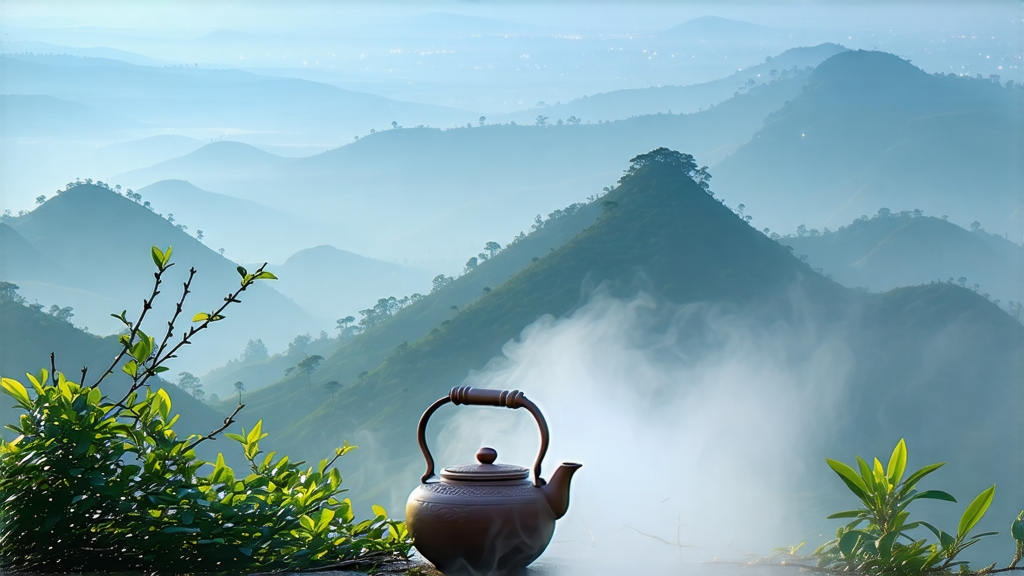
If every tea tells a story, Lapsang Souchong whispers the first chapter of black tea itself. International drinkers often equate “Chinese black tea” with malty Yunnan gold tips or brisk Keemun, yet the earliest black tea ever documented was born in the craggy Wuyi Mountains of northern Fujian around 1568—centuries before Assam or Ceylon cultivars existed. Locals call it Zheng Shan Xiao Zhong, literally “Original-Mountain Small-Kind,” the word xiao zhong denoting the diminutive cultivar from which it was picked. European traders latinized the name into Lapsang Souchong, and the tea sailed out of Xiamen port to Amsterdam and London, forever changing global taste. What left the dock was not merely leaf but a sensory passport: the perfume of pine smoke that would soon define “black tea” in the Western imagination.
Terroir: why Wuyi matters
The Wuyi range is a UNESCO geopark of vertical cliffs, mineral-rich igneous rock, and a subtropical monsoon climate that traps cloud cover like a lid. Day-night temperature swings of 15 °C slow the growth of tea bushes, condensing amino acids and volatiles. The soil is so porous that rainwater drains instantly, forcing roots to mine magnesium and potassium from weathered tuff. The result is a natural umami backbone that can survive the dramatic smoking process without collapsing into astringency. Only leaves picked within the 60 km² core zone—Tongmu Guan, Guadun, Miaowan—may legally bear the designation Zheng Shan Xiao Zhong; everything else is simply “smoked black tea.”
Two families, two styles
- Traditional pine-smoke Lapsang: After the last ice age, Tongmu villagers had no kiln-dried firewood; they burned local Masson pine and red pine to wither tea. Accident became signature. Today the same technique persists. Fresh leaves are first withered over embers inside slatted wooden lofts called qing lou. Once 65 % of moisture is gone, they are rolled until juice films the surface, then oxidized in bamboo baskets nested in cloth. The critical step is firing: pinewood is stacked in pits below brick trays; tea masters shuffle the leaves every three minutes for eight hours, absorbing guaiacol and syringol—the same molecules that give bacon its aroma. A final charcoal bake fixes the smoke, yielding a glossy, jet-black strip that smells like pine resin, dried longan, and cured ham.
- Unsmoked “new craft” Lapsang: In 2005 a Tongmu master named Jiang Yuanxun experimented with drying over electric heat to suit modern palates. The absence of smoke allows honeyed lychee and roasted sweet-potato notes to surface. Purists debate its authenticity, yet the unsmoked version now commands higher auction prices in Shanghai than its campfire sibling. Both styles share the same cultivar—often the small-leaf Wuyi Qizhong or the even rarer Caicha—but diverge in the last 5 % of processing, proving how aroma is a decision rather than destiny.
Craft in miniature
A single 500 g batch needs 55 000 buds. Pickers climb 70-degree slopes before 9 a.m., selecting the standard “two leaves and a half-open bud.” Any larger and the smoke will taste tarry; any smaller and the cup will be thin. Leaves must reach the qing lou within two hours; enzymatic browning waits for no one. The master gauges wither by ear: rubbing a leaf between palms should produce the rustle of silk, not parchment. Oxidation is arrested the instant the leaf edge turns maroon—about 110 minutes in May, 80 minutes in humid June. Timing errors cannot be corrected; over-oxidized leaf will smell of boiled potatoes forever.
Brewing: gongfu versus mug
Western texts often recommend boiling water and five-minute steeps, but that extracts creosote-like bitterness. For smoked Lapsang, treat the leaf like a peated whisky: respect the smoke, invite the sweetness beneath.
Gongfu method (preferred)
- 5 g leaf, 120 ml porcelain gaiwan, 95 °C water.
- Flash rinse to wake the leaf, discard